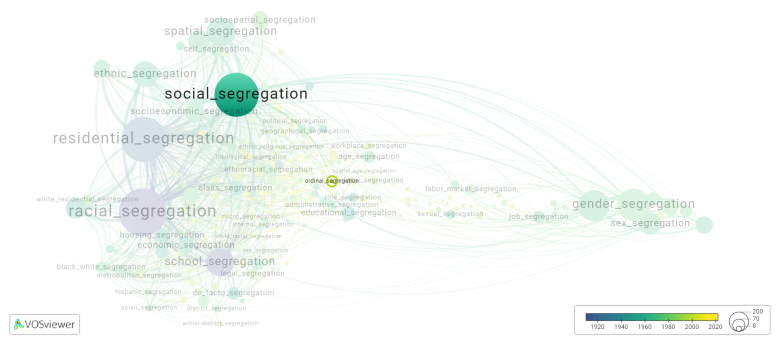Ordinal segregation: Difference between revisions
(Creating page) |
(Creating page) |
||
| (7 intermediate revisions by the same user not shown) | |||
| Line 1: | Line 1: | ||
===== Date and country of first publication<ref>Date and country of first publication as informed by the Scopus database (December 2023).</ref>===== | |||
2009<br> | |||
United States | |||
===== Definition ===== | |||
Ordinal segregation refers to the practice of dividing or segregating individuals based on their ordinal position or rank in a particular group, such as a hierarchy or social class. This can be seen in various aspects of society, including education, employment, and political systems. | Ordinal segregation refers to the practice of dividing or segregating individuals based on their ordinal position or rank in a particular group, such as a hierarchy or social class. This can be seen in various aspects of society, including education, employment, and political systems. | ||
| Line 14: | Line 14: | ||
Overall, ordinal segregation perpetuates social stratification and reinforces systems of privilege and disadvantage based on one's position or rank within a particular group or society. | Overall, ordinal segregation perpetuates social stratification and reinforces systems of privilege and disadvantage based on one's position or rank within a particular group or society. | ||
==See also== | ==See also== | ||
==Related segregation forms== | |||
Ordinal segregation is frequently discussed in the literature with the following segregation forms: | |||
[[social segregation]], [[occupational segregation]], [[spatial segregation]], [[school segregation]], [[within-school segregation]] | |||
[[File:ordinal_segregation.png|780x780px]] | |||
This visualization is based on the study [[Segregation_Wiki:About| The Multidisciplinary Landscape of Segregation Research]]. | |||
For the complete network of interrelated segregation forms, please refer to: | |||
* [https://tinyurl.com/2235lkhw First year of publication] | |||
* [https://tinyurl.com/2d8wg5n3 Louvain clusters] | |||
* [https://tinyurl.com/223udk5r Betweenness centrality] | |||
* [https://tinyurl.com/244d8unz Disciplines in which segregation forms first emerged (Scopus database).] | |||
==References== | ==References== | ||
==Notes== | ==Notes== | ||
<references /> | <references /> | ||
{{NoteAI}} | {{NoteAI}} | ||
== | ==Ordinal segregation appears in the following literature== | ||
Reardon S.F. (2009) | Reardon S.F. (2009). Measures of ordinal segregation. ''Research on Economic Inequality'', ''17''(), 129-155. https://doi.org/10.1108/S1049-2585(2009)0000017011 | ||
Silber J. | Silber J., Yalonetzky G. (2011). Measuring inequality in life chances with ordinal variables. ''Research on Economic Inequality'', ''19''(), 77-98. https://doi.org/10.1108/S1049-2585(2011)0000019007 | ||
Monkkonen P. | Monkkonen P., Zhang X. (2014). Innovative measurement of spatial segregation: Comparative evidence from Hong Kong and San Francisco. ''Regional Science and Urban Economics'', ''47''(1), 99-111. Elsevier.https://doi.org/10.1016/j.regsciurbeco.2013.09.016 | ||
Ivaniushina V. | Ivaniushina V., Makles A.M., Schneider K., Alexandrov D. (2019). School segregation in St. Petersburg the role of socioeconomic status. ''Education Economics'', ''27''(2), 166-185. Routledge.https://doi.org/10.1080/09645292.2018.1538408 | ||
Latest revision as of 07:17, 16 October 2024
Date and country of first publication[1][edit | edit source]
2009
United States
Definition[edit | edit source]
Ordinal segregation refers to the practice of dividing or segregating individuals based on their ordinal position or rank in a particular group, such as a hierarchy or social class. This can be seen in various aspects of society, including education, employment, and political systems.
For example, in education, ordinal segregation may manifest as tracking or ability grouping, where students are placed into different classes or programs based on their academic performance or abilities. This can result in unequal access to resources and opportunities, leading to disparities in educational outcomes.
In the workplace, ordinal segregation can occur through the hierarchical structure of organizations, where individuals in higher positions have more power, privileges, and opportunities compared to those in lower positions. This can contribute to income inequality and limited upward mobility for individuals in lower ranks.
Ordinal segregation can also be observed in political contexts, where certain groups or classes are granted more political power and influence than others. This can result in unequal representation and decision-making processes, further exacerbating social inequalities.
Overall, ordinal segregation perpetuates social stratification and reinforces systems of privilege and disadvantage based on one's position or rank within a particular group or society.
See also[edit | edit source]
Related segregation forms[edit | edit source]
Ordinal segregation is frequently discussed in the literature with the following segregation forms:
social segregation, occupational segregation, spatial segregation, school segregation, within-school segregation

This visualization is based on the study The Multidisciplinary Landscape of Segregation Research.
For the complete network of interrelated segregation forms, please refer to:
References[edit | edit source]
Notes[edit | edit source]
- ↑ Date and country of first publication as informed by the Scopus database (December 2023).
At its current state, this definition has been generated by a Large Language Model (LLM) so far without review by an independent researcher or a member of the curating team of segregation experts that keep the Segregation Wiki online. While we strive for accuracy, we cannot guarantee its reliability, completeness and timeliness. Please use this content with caution and verify information as needed. Also, feel free to improve on the definition as you see fit, including the use of references and other informational resources. We value your input in enhancing the quality and accuracy of the definitions of segregation forms collectively offered in the Segregation Wiki ©.
Ordinal segregation appears in the following literature[edit | edit source]
Reardon S.F. (2009). Measures of ordinal segregation. Research on Economic Inequality, 17(), 129-155. https://doi.org/10.1108/S1049-2585(2009)0000017011
Silber J., Yalonetzky G. (2011). Measuring inequality in life chances with ordinal variables. Research on Economic Inequality, 19(), 77-98. https://doi.org/10.1108/S1049-2585(2011)0000019007
Monkkonen P., Zhang X. (2014). Innovative measurement of spatial segregation: Comparative evidence from Hong Kong and San Francisco. Regional Science and Urban Economics, 47(1), 99-111. Elsevier.https://doi.org/10.1016/j.regsciurbeco.2013.09.016
Ivaniushina V., Makles A.M., Schneider K., Alexandrov D. (2019). School segregation in St. Petersburg the role of socioeconomic status. Education Economics, 27(2), 166-185. Routledge.https://doi.org/10.1080/09645292.2018.1538408
